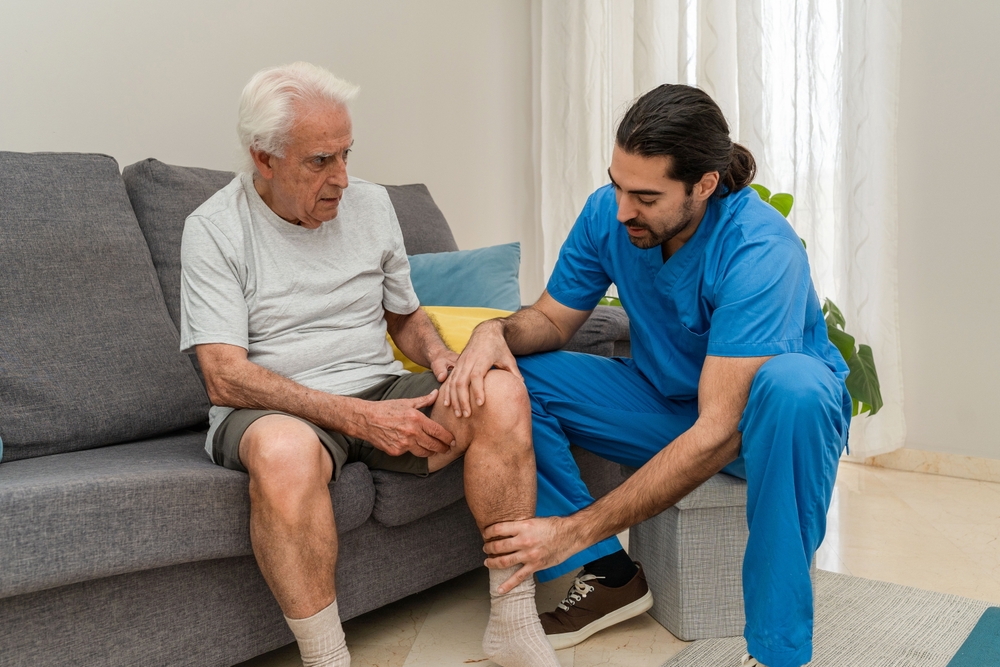An Empathetic Approach To Ease Chronic Pain
No matter the root cause — arthritis, multiple sclerosis, post-surgical complications, or age-related conditions, chronic pain doesn’t just impact the body. It can dim a once vibrant personality, strain relationships, and make even simple daily tasks feel overwhelming.
For seniors and adults with disabilities throughout New York, home health aides are trusted companions who bring comfort, stability, and understanding right into the comfort of home.
At Americare, we believe that managing chronic pain entails more than a medication schedule. It’s about having someone who truly understands you, who moves at your pace, and who helps restore the routines that make home feel like home again.
When Pain Becomes A Daily Companion
Common Causes Of Chronic Pain
According to the CDC, roughly 20% of U.S. adults suffer from chronic pain, with the numbers being significantly higher among those aged 65 and older.
Common causes include:
- Arthritis – A leading cause of pain and mobility issues in seniors.
- Back and spine conditions – Often worsened by aging or physical strain.
- Post-operative pain – Following surgeries like joint replacements or cancer-related procedures.
- Neurological diseases – Such as multiple sclerosis, which often involve both pain and fatigue.
In many cases, these conditions overlap with other chronic conditions like diabetes or heart disease, making day to day life even harder to navigate.
The Emotional Toll
Pain has a way of touching every part of life. Chronic pain can lead to depression and anxiety, sleep disturbances, social withdrawal, and strained family relationships, making it crucial to address symptoms before things spiral out of control.
Caregivers often feel overwhelmed trying to juggle their loved one’s physical needs while offering emotional support. This is where chronic pain homecare can be a lifeline—not only for the person in pain, but for the whole family.
How Home Health Aides Ease The Pain
Compassionate Care In The Comfort Of Home
When pain makes everyday tasks difficult, home health aides can provide practical, gentle assistance in many ways, helping you or your loved one with:
- Bathing and dressing in ways that minimize discomfort
- Using bathroom safety modifications to reduce the risk of falls
- Guided movement or gentle stretching to prevent stiffness
- Meal preparation to support a healthy, balanced diet
Creating a consistent routine is another valuable gift home health aides can offer their patients When pain is unpredictable, having a steady schedule throughout the day helps the body find its own natural balance.
Connecting The Dots In Medical Care
Home health aides don’t provide medical treatment, but they are trained to observe and report changes. A good aide acts as the “eyes and ears” at home, noticing patterns, identifying new symptoms (e.g., swelling, reduced mobility, medication side effects), and most importantly, always keeping family and medical providers informed of any red flags
Emotional And Social Support
Isolation often amplifies pain. Many seniors report that just having someone present to listen, to chat with, lowers their anxiety and makes pain more tolerable.
In the haze of constant pain, it’s hard to enjoy life’s little pleasures. At Americare, our home health aides take special notice of their patient’s hobbies and favorite past times, and make time to focus on those activities.
This kind of genuine connection naturally builds trust over time. When someone feels truly seen and understood, they’re more likely to be honest about their pain levels, their fears, and their needs.
When Is It Time To Consider In-Home Chronic Pain Care?

Sometimes the signs that your loved one needs extra support develop gradually. Maybe they’re finding everyday tasks more challenging, or they’re just not quite themselves — more withdrawn, easily frustrated, or worried about things that didn’t bother them in the past.
Other times, the signs are more concrete: a scary fall, medication mix ups, or untouched meals because they’re in too much pain to eat. Let your loved one know that these aren’t failures — they are signals that pain management at home has become too complex for one person to handle alone.
Sometimes chronic pain exists alongside other health challenges, whether mobility and balance issues ,a condition like cerebral palsy, or Parkinson’s disease. When multiple health issues intersect, pain management becomes part of a broader conversation about comprehensive care that supports both comfort and independence.
The Americare Approach – Comprehensive, Compassionate Pain Support
Every aide on the Americare team is joined by a single mindset — living with chronic pain doesn’t have to mean living without peace, dignity, or comfort.
Our home health aides create care plans that are fully customized, and focus on the individual diagnosis, pain levels, and home environment. From home care for arthritis, support for people with multiple sclerosis, or those who need help managing respiratory challenges, every aspect of our services is tailored to the needs of whoever we’re caring for.
We also understand that many people we serve are managing multiple health challenges or age-related changes alongside their pain. That’s why our aides receive specialized training in adaptive care techniques—ensuring they can provide respectful, pain-aware support no matter how complex the patient’s situation may be.
A Brighter Tomorrow Starts Today
Chronic pain may be part of your loved one’s reality—but suffering doesn’t have to be. With the right support, life at home can still be rich in connection, comfort, and dignity.
If you’re ready to explore how in-home care can ease pain and lighten the emotional load, contact our team at Americare today.
Tips for Communicating Pain Levels to Caregivers
Many seniors underreport their pain — either because they don’t want to “complain” or because they assume it’s a normal part of aging. But in reality, open, honest communication is key to effective care.
Here are a few ways to help track pain levels.
- Use a pain scale (0–10) to make pain levels more concrete
- Ask your loved one to describe the pain (sharp, dull, stabbing, burning)
- Track timing and triggers (Does it worsen at night? After walking?)
- Note how it affects activities (Is it stopping them from getting dressed or going out?)

